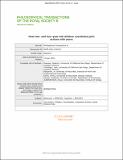How 2- and 4-year-old children coordinate social interactions with peers
Abstract
The Interaction Engine Hypothesis postulates that humans have a unique ability and motivation for social interaction. A crucial juncture in the ontogeny of the interaction engine could be around 2–4 years of age, but observational studies of children in natural contexts are limited. These data appear critical also for comparison with non-human primates. Here, we report on focal observations on 31 children aged 2- and 4-years old in four preschools (10 h per child). Children interact with a wide range of partners, many infrequently, but with one or two close friends. Four-year olds engage in cooperative social interactions more often than 2-year olds and fight less than 2-year olds. Conversations and playing with objects are the most frequent social interaction types in both age groups. Children engage in social interactions with peers frequently (on average 13 distinct social interactions per hour) and briefly (28 s on average) and shorter than those of great apes in comparable studies. Their social interactions feature entry and exit phases about two-thirds of the time, less frequently than great apes. The results support the Interaction Engine Hypothesis, as young children manifest a remarkable motivation and ability for fast-paced interactions with multiple partners.
Citation
Rossano , F , Terwilliger , J , Bangerter , A , Genty , E , Heesen , R & Zuberbühler , K 2022 , ' How 2- and 4-year-old children coordinate social interactions with peers ' , Philosophical Transactions of the Royal Society B: Biological Sciences , vol. 377 , no. 1859 , 20210100 . https://doi.org/10.1098/rstb.2021.0100
Publication
Philosophical Transactions of the Royal Society B: Biological Sciences
Status
Peer reviewed
ISSN
0962-8436Type
Journal article
Description
This study was funded by Swiss National Science Foundation, grant no. CR31I3_166331 awarded to A.B. and K.Z., Social Science Research Grant, University of California, San Diego, Socialization in young children awarded to F.R., Yankelovich Center University of California, San Diego, A tale of two cultures awarded to F.R.Collections
Items in the St Andrews Research Repository are protected by copyright, with all rights reserved, unless otherwise indicated.

